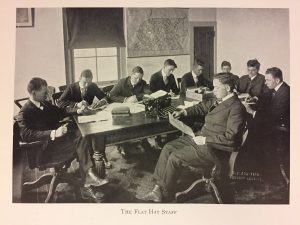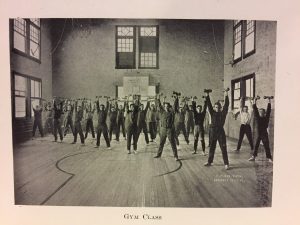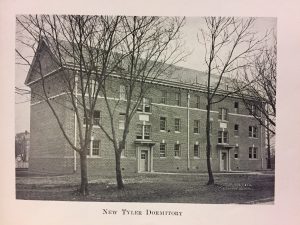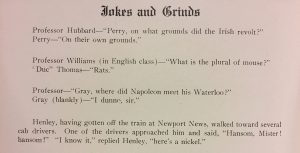If you’re a senior at the College, you may know the Colonial Echo through their emails reminding you to get your portrait taken. If you’re an underclassman, perhaps you’ve seen the Colonial Echo up for grabs around campus at the end of the Spring semester. For those still unfamiliar, the Colonial Echo is William & Mary’s student yearbook; it’s a record of the events throughout the year and the students who matriculated. The Colonial Echo was first published in 1899, and has been published every year since then except for 1900 and 1904. That means there have been over 100 editions of the yearbook, and Special Collections has a copy (or multiples) of every edition. While physical copies are available, you don’t have to actually come into Special Collections to view the Colonial Echo – the 1899-1995 yearbooks have been digitized. To give you a glimpse into W&M’s history, we pulled the 1917 Colonial Echo. Exactly 100 years from the current academic year, this yearbook is a great example of what has – and has not – changed on campus since its publication.
 "Flat Hat," p. 80. The Flat Hat staff was still hard at work in 1917, rushing to finish the week’s paper.
"Flat Hat," p. 80. The Flat Hat staff was still hard at work in 1917, rushing to finish the week’s paper.
100 years ago, women couldn’t vote and weren’t allowed in many universities – and W&M was no exception. In 1917 women weren’t admitted to the college in any capacity, so everyone – administrators, faculty and students – featured in the 1917 yearbook is male, a stark contrast to today, when female students actually outnumber male. However, it’s important to note that in the next year W&M made the decision to admit women long before many other comparable universities did.
 "Gym Class," p. 8. A gym class being held in 1917, when gym was still part of the curriculum! Clearly the 1917 gymnasium was a little different from today’s Rec Center.
"Gym Class," p. 8. A gym class being held in 1917, when gym was still part of the curriculum! Clearly the 1917 gymnasium was a little different from today’s Rec Center.
Not only was class composition different, but class size was as well. Compared to today’s class sizes of about 1,500 students, the class sizes of 1917 were tiny – the senior class only had 20 students. This was due not only to the fact that the College was much smaller at the time, but also to many students leaving campus to fight in World War I.
 "Tyler Hall," p. 9. In 1917 Tyler Hall was newly opened, only it didn’t house government, economics, international relations or public policy – it housed students as a dorm!
"Tyler Hall," p. 9. In 1917 Tyler Hall was newly opened, only it didn’t house government, economics, international relations or public policy – it housed students as a dorm!
W&M has always been a school that values traditions. While we cherish our traditions today, there are a few displayed in 1917 that haven’t quite carried over to the present day: for instance, the “Senior Class Prophecy.” A member of the graduating class was elected to be the “Prophet” – yes, that was a class officer position – and they wrote a prediction of what was to come for the graduating class, to be published in the final pages of their class’s section of the Colonial Echo. Another feature that hasn’t survived is the “Colonial Echo Election.” The Colonial Echo assigned “winners” to superlatives such as “Tobacco Bum,” “Dill Picker,” and “Ugliest Man,” among others.
 "Jokes and Grinds," p. 172. Some jokes are always classic, like these few about that embarrassing moment when you say something completely wrong in class.
"Jokes and Grinds," p. 172. Some jokes are always classic, like these few about that embarrassing moment when you say something completely wrong in class.
 "Jokes," p. 137. A few of the featured jokes and grinds are particularly relevant to events today, like these two about debates and dining hall food.
"Jokes," p. 137. A few of the featured jokes and grinds are particularly relevant to events today, like these two about debates and dining hall food.
Also present throughout the 1917 Colonial Echo is a sense of humor, something still important to students at the College today. And while they didn’t have “Overheard at W&M” as an online forum for humor in 1917, the Colonial Echo had a “Jokes and Grinds” section that served basically the same purpose.
Students joked about the same things as they do today, like dining hall food, dating, and silly comments their fellow students made in class. Also interspersed throughout the yearbook are funny poems, stories, and even an entire short play.
While paging through the 1917 Colonial Echo, it’s evident just from the fashion and hairstyles that a lot has changed in the 100 years since its publication. But despite the differences on campus then, it’s easy to see commonalities and links to campus now. Visit the digital archives to check out the 1917 Colonial Echo and other publications from W&M’s history!
Post written by Dana Florczak, Special Collections Student Assistant